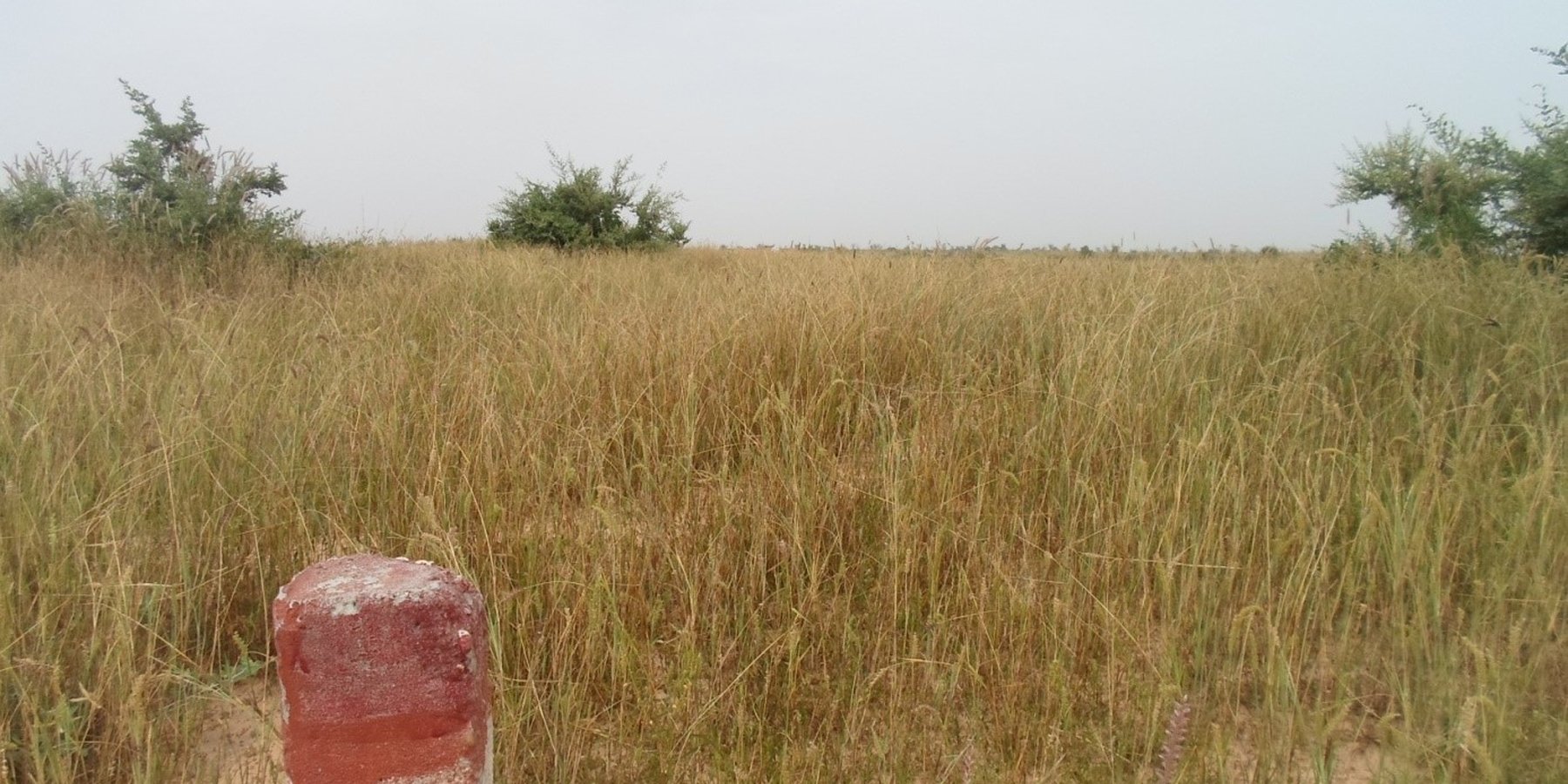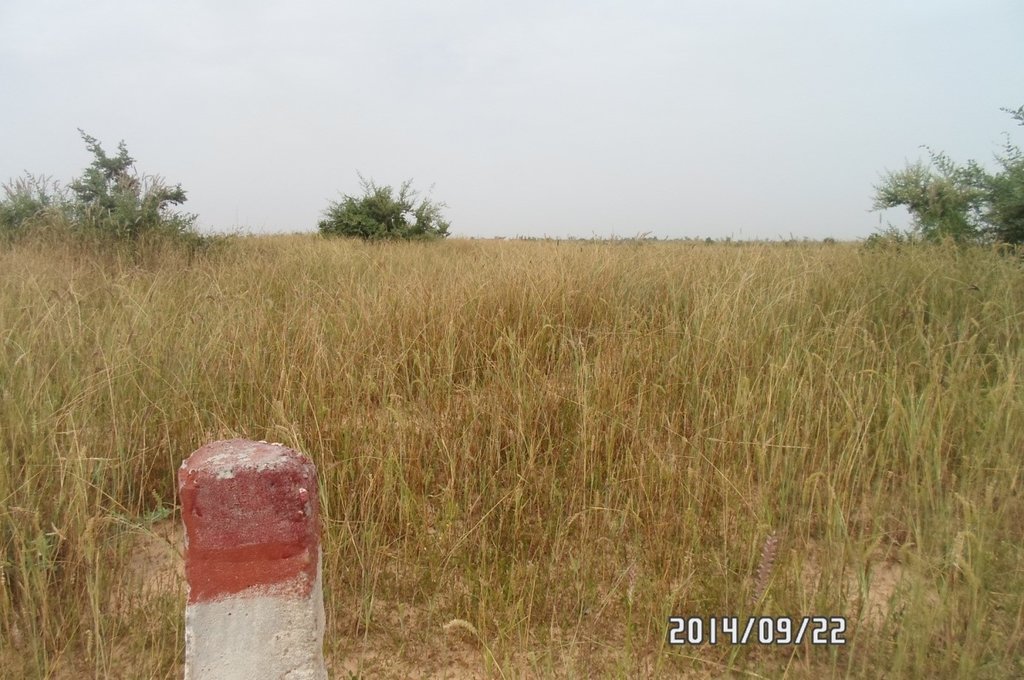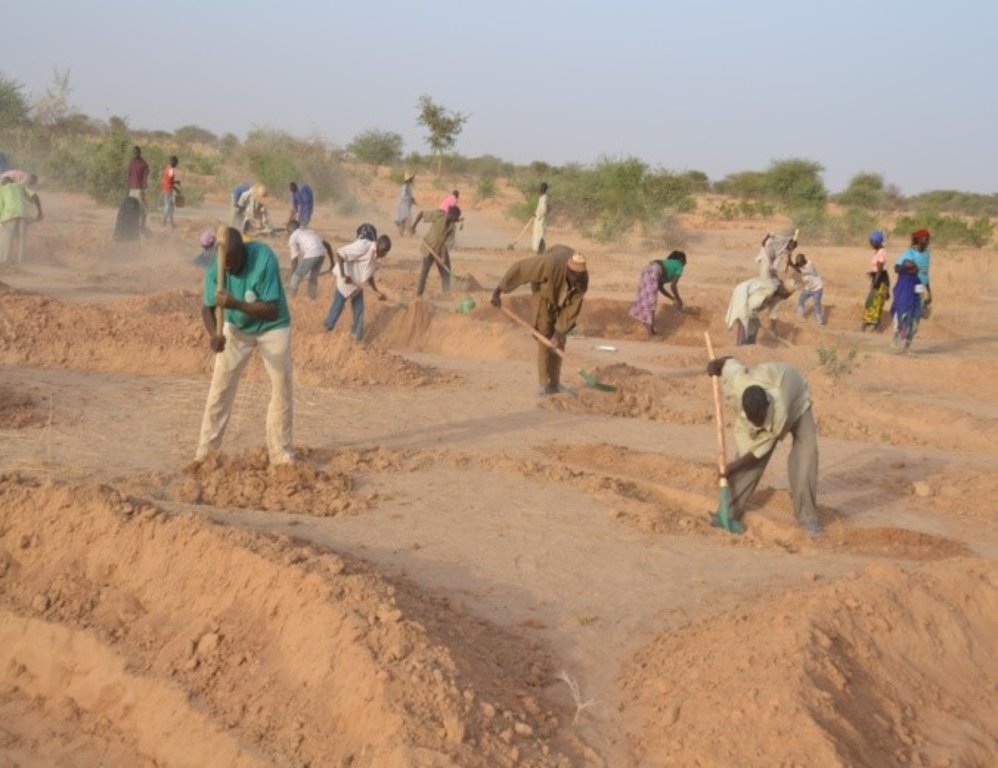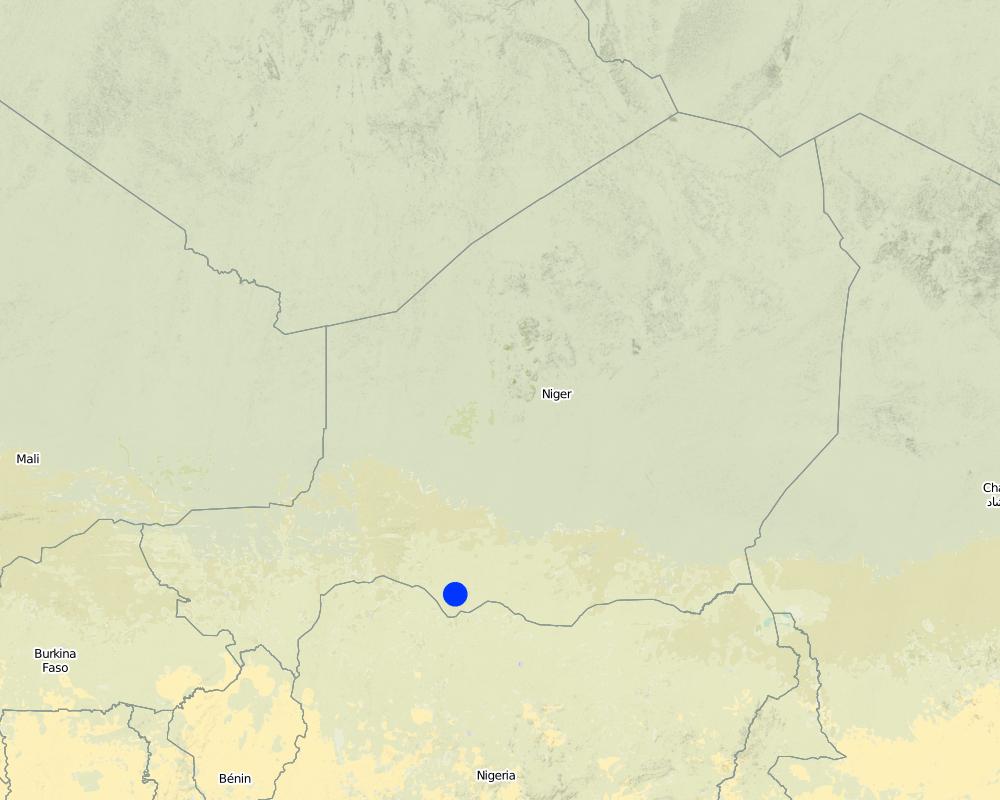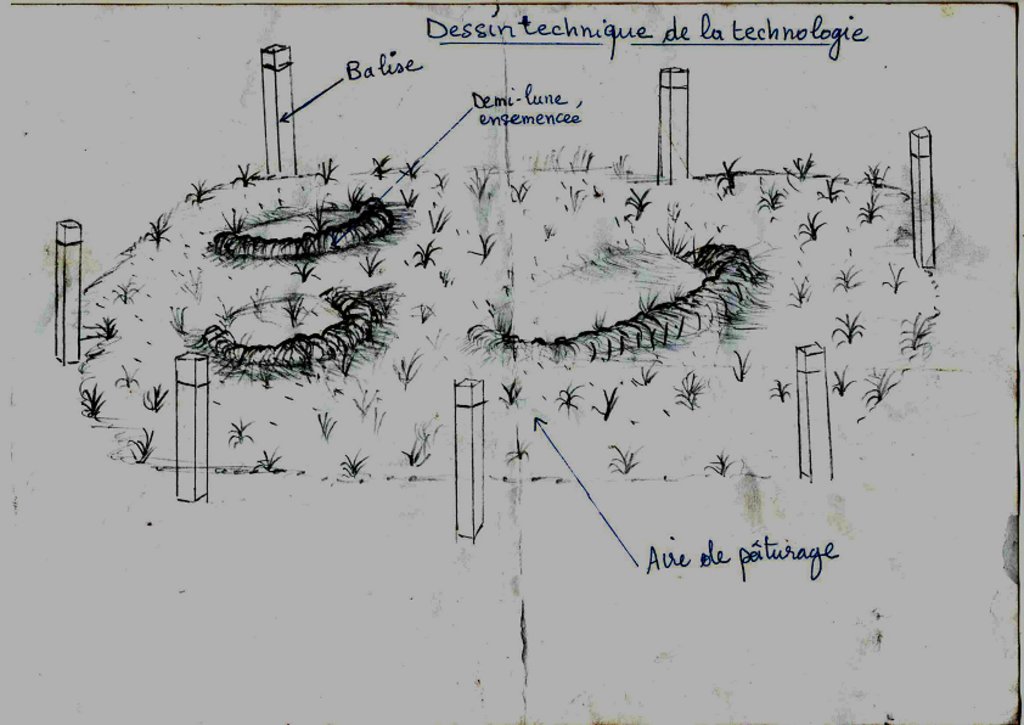Réhabilitation et protection de l'aire de paturage de Guidan Issa [Niger]
- Creation:
- Update:
- Compiler: Maman Aicha
- Editor: –
- Reviewer: David Beritault
technologies_689 - Niger
View sections
Expand all Collapse all1. General information
1.2 Contact details of resource persons and institutions involved in the assessment and documentation of the Technology
Key resource person(s)
land user:
Maman Aichatou
0022796978271 / 0022796769648
achdoutchi@yahoo.fr / abdoulhadikassoum@yahoo.fr
Zamtapo
BP:391
Niger
Name of project which facilitated the documentation/ evaluation of the Technology (if relevant)
Book project: where people and their land are safer - A Compendium of Good Practices in Disaster Risk Reduction (DRR) (where people and their land are safer)Name of the institution(s) which facilitated the documentation/ evaluation of the Technology (if relevant)
HEKS (Hilfswerk der Evangelischen Kirchen Schweiz) (HEKS (Hilfswerk der Evangelischen Kirchen Schweiz)) - Switzerland1.3 Conditions regarding the use of data documented through WOCAT
When were the data compiled (in the field)?
26/10/2016
The compiler and key resource person(s) accept the conditions regarding the use of data documented through WOCAT:
Ja
1.4 Declaration on sustainability of the described Technology
Is the Technology described here problematic with regard to land degradation, so that it cannot be declared a sustainable land management technology?
Nee
2. Description of the SLM Technology
2.1 Short description of the Technology
Definition of the Technology:
La réhabilitation d'une aire de pâturage consiste au balisage de cette aire puis à son ensemencement par des herbacées adaptées aux zones arides et aux sols dégradés.
2.2 Detailed description of the Technology
Description:
La pression démographique conjuguée à l’augmentation du cheptel a entraîné l’occupation anarchique des couloirs de passage, des aires de pâturage et des abords de points d’eau pourtant matérialisés par le passé. Cette occupation des espaces réservés à l’élevage a engendré des répercussions socio-économiques néfastes :
- l’insuffisance des ressources pastorales,
- la multiplication des conflits entre agriculteurs et éleveurs.
Dans ce contexte de dégradation des ressources naturelles, la population de Guidan Issa à travers les autorités départementales et communales a sollicité l’appui méthodologique et financier du projet Zamtapo. Cette réhabilitation concerne non seulement le balisage mais aussi l’ensemencement de certaines herbacées comme le Cencrus biflorus (une herbacée épineuse de la famille des Poaceae dont les graines s'accrochent aux vêtements) et l'Adropogon gayanus. Elles sont adaptées aux zones arides et semi arides, se rencontre généralement sur les sols sableux et sont très appétées par les animaux.
Pour le balisage qui constitue la première étape de la technologie, cette opération consiste à la mise en place de bornes bétonnées par intervalle de 50m. Elle intervient après la délimitation et vise à donner un caractère officiel à l’opération. Au total 200 balises ont été implantées sur l’aire qui couvre 29,5 ha.
Pour l’ensemencement, les ouvrages choisis pour cette aire de pâturage sont les demi-lunes, qui sont des cuvettes en forme de demi-cercle faisant partie des mesures de Conservation des Eaux du Sol (CES) et de Défense et Restauration des Sols (DRS). La terre de déblais est déposée sur le demi-cercle en un bourrelet semi-circulaire au sommet aplati. Leurs implantations se font par pivotement à l'aide d’un compas de 2 m de rayon. Les dimensions couramment utilisées sont : diamètre de 4 m et profondeur de 0,15 à 0,25 m. L’objectif de l’ensemencement par demi-lune est de réhabiliter les sols dégradés, conserver les eaux de pluies et améliorer la fertilité du sol.
Les intrants nécessaires pour mettre en œuvre et entretenir la technologie sont: les matériels aratoires pour la réalisation des ouvrages CES/DRS, les balises en béton armée pour la délimitation de l'aire et les semences fourragères pour l’ensemencement de l'espace dénudé.
Les avantages de cette technologie sont qu'elle réduit le risque des conflits fonciers et fait la promotion d'un élevage d’excellence.
2.3 Photos of the Technology
2.5 Country/ region/ locations where the Technology has been applied and which are covered by this assessment
Country:
Niger
Region/ State/ Province:
Département de Mayahi, région de Maradi
Map
×2.6 Date of implementation
If precise year is not known, indicate approximate date:
- less than 10 years ago (recently)
2.7 Introduction of the Technology
Specify how the Technology was introduced:
- through projects/ external interventions
Comments (type of project, etc.):
Projet d'appui à la sécurisation de la mobilité des troupeaux dans la région de Maradi/Niger (ZAMTAPO avec financement de HEKS)
3. Classification of the SLM Technology
3.1 Main purpose(s) of the Technology
- improve production
- reduce, prevent, restore land degradation
- create beneficial economic impact
- create beneficial social impact
3.2 Current land use type(s) where the Technology is applied

Grazing land
Extensive grazing land:
- Semi-nomadism/ pastoralism
Intensive grazing/ fodder production:
- Improved pastures
Main animal species and products:
Ovin, bovin, camelin, caprin
Comments:
L'aire est juste utilisée pour le pâturage.
If land use has changed due to the implementation of the Technology, indicate land use before implementation of the Technology:
Avant la mise en oeuvre de la technologie, l'espace était dénudé, il n'y avait pas de fourrage pour les animaux.
3.3 Further information about land use
Water supply for the land on which the Technology is applied:
- rainfed
Comments:
La principale période de croissance est de Juillet à Septembre (période des pluies)
Number of growing seasons per year:
- 1
3.4 SLM group to which the Technology belongs
- pastoralism and grazing land management
- improved ground/ vegetation cover
3.5 Spread of the Technology
Specify the spread of the Technology:
- evenly spread over an area
If the Technology is evenly spread over an area, indicate approximate area covered:
- 0.1-1 km2
Comments:
L'aire de Guidan Issa a une superficie de 29 ha
3.6 SLM measures comprising the Technology

vegetative measures
- V2: Grasses and perennial herbaceous plants

structural measures
- S6: Walls, barriers, palisades, fences

management measures
- M1: Change of land use type
3.7 Main types of land degradation addressed by the Technology

biological degradation
- Bc: reduction of vegetation cover
- Bq: quantity/ biomass decline
- Bs: quality and species composition/ diversity decline
3.8 Prevention, reduction, or restoration of land degradation
Specify the goal of the Technology with regard to land degradation:
- restore/ rehabilitate severely degraded land
4. Technical specifications, implementation activities, inputs, and costs
4.1 Technical drawing of the Technology
4.2 Technical specifications/ explanations of technical drawing
La terre de déblais est déposée sur le demi-cercle en un bourrelet semi-circulaire au sommet aplati. Leurs implantations se font par pivotement à l'aide d’un compas de 2 m de rayon. Les dimensions couramment utilisées sont : diamètre de 4 m et profondeur de 0,15 à 0,25 m. L’objectif de l’ensemencement par demi-lune est de réhabiliter les sols dégradés, conserver les eaux de pluies et améliorer la fertilité du sol.
4.3 General information regarding the calculation of inputs and costs
Specify how costs and inputs were calculated:
- per Technology area
Indicate size and area unit:
29,5 ha
other/ national currency (specify):
FCFA
Indicate exchange rate from USD to local currency (if relevant): 1 USD =:
550.0
Indicate average wage cost of hired labour per day:
1500 FCA
4.4 Establishment activities
| Activity | Type of measure | Timing | |
|---|---|---|---|
| 1. | Balisage | Structural | Mars |
| 2. | Inscription au registre rural | Management | Mars |
| 3. | Aménagement (construction des demi-lunes) | Structural | Juin (avant la saison pluvieuse) |
| 4. | Ensemencement | Vegetative | Juillet (pendant la saison pluvieuse) |
| 5. | Formations en techniques de récolte des semences | Management | Octobre |
4.5 Costs and inputs needed for establishment
| Specify input | Unit | Quantity | Costs per Unit | Total costs per input | % of costs borne by land users | |
|---|---|---|---|---|---|---|
| Labour | main d'oeuvre | homme.jour | 138.0 | 1500.0 | 207000.0 | 25.0 |
| Equipment | pelles | 138.0 | 1000.0 | 138000.0 | ||
| Equipment | houe | 138.0 | 1000.0 | 138000.0 | ||
| Equipment | Balises | 200.0 | 16000.0 | 3200000.0 | ||
| Plant material | Chencrus biflorus | kilogramme | 87.0 | 5000.0 | 435000.0 | 25.0 |
| Plant material | Adropogon gayanus | kilogramme | 120.0 | 5000.0 | 600000.0 | |
| Total costs for establishment of the Technology | 4718000.0 | |||||
If land user bore less than 100% of costs, indicate who covered the remaining costs:
Le projet Zamtapo a financé le coût restant
Comments:
Le site pastoral de Guidan Issa a une superficie de 29.5ha. 138 producteurs (hommes/femmes) avec 138 pelles et houes ont travaillé sur l'aire pendant 10 Jours. Il n'y a pas besoin d'engrais, le balisage est inclus.
4.8 Most important factors affecting the costs
Describe the most determinate factors affecting the costs:
- Le balisage
- Achat des semences
5. Natural and human environment
5.1 Climate
Annual rainfall
- < 250 mm
- 251-500 mm
- 501-750 mm
- 751-1,000 mm
- 1,001-1,500 mm
- 1,501-2,000 mm
- 2,001-3,000 mm
- 3,001-4,000 mm
- > 4,000 mm
Specifications/ comments on rainfall:
La saison des pluies se situe de Juillet à Septembre
Indicate the name of the reference meteorological station considered:
Mayahi
Agro-climatic zone
- semi-arid
5.2 Topography
Slopes on average:
- flat (0-2%)
- gentle (3-5%)
- moderate (6-10%)
- rolling (11-15%)
- hilly (16-30%)
- steep (31-60%)
- very steep (>60%)
Landforms:
- plateau/plains
- ridges
- mountain slopes
- hill slopes
- footslopes
- valley floors
Altitudinal zone:
- 0-100 m a.s.l.
- 101-500 m a.s.l.
- 501-1,000 m a.s.l.
- 1,001-1,500 m a.s.l.
- 1,501-2,000 m a.s.l.
- 2,001-2,500 m a.s.l.
- 2,501-3,000 m a.s.l.
- 3,001-4,000 m a.s.l.
- > 4,000 m a.s.l.
Indicate if the Technology is specifically applied in:
- not relevant
5.3 Soils
Soil depth on average:
- very shallow (0-20 cm)
- shallow (21-50 cm)
- moderately deep (51-80 cm)
- deep (81-120 cm)
- very deep (> 120 cm)
Soil texture (topsoil):
- coarse/ light (sandy)
Soil texture (> 20 cm below surface):
- coarse/ light (sandy)
Topsoil organic matter:
- medium (1-3%)
5.4 Water availability and quality
Ground water table:
> 50 m
Availability of surface water:
medium
Water quality (untreated):
poor drinking water (treatment required)
Is water salinity a problem?
Nee
Is flooding of the area occurring?
Nee
5.5 Biodiversity
Species diversity:
- low
Habitat diversity:
- low
5.6 Characteristics of land users applying the Technology
Sedentary or nomadic:
- Semi-nomadic
Market orientation of production system:
- mixed (subsistence/ commercial
Off-farm income:
- less than 10% of all income
Relative level of wealth:
- poor
Individuals or groups:
- individual/ household
Level of mechanization:
- manual work
Gender:
- women
- men
Age of land users:
- middle-aged
5.7 Average area of land owned or leased by land users applying the Technology
- < 0.5 ha
- 0.5-1 ha
- 1-2 ha
- 2-5 ha
- 5-15 ha
- 15-50 ha
- 50-100 ha
- 100-500 ha
- 500-1,000 ha
- 1,000-10,000 ha
- > 10,000 ha
Is this considered small-, medium- or large-scale (referring to local context)?
- small-scale
5.8 Land ownership, land use rights, and water use rights
Land ownership:
- individual, not titled
Land use rights:
- open access (unorganized)
- communal (organized)
Water use rights:
- open access (unorganized)
5.9 Access to services and infrastructure
health:
- poor
- moderate
- good
education:
- poor
- moderate
- good
technical assistance:
- poor
- moderate
- good
employment (e.g. off-farm):
- poor
- moderate
- good
markets:
- poor
- moderate
- good
energy:
- poor
- moderate
- good
roads and transport:
- poor
- moderate
- good
drinking water and sanitation:
- poor
- moderate
- good
financial services:
- poor
- moderate
- good
6. Impacts and concluding statements
6.1 On-site impacts the Technology has shown
Socio-economic impacts
Production
fodder production
Quantity after SLM:
29.91 tonnes de matière seche
Comments/ specify:
L'aire de pâturage était un espace dénudé dépourvu de tout fourrage avant d’être aménagé. Mais après la réhabilitation l'aire a régénéré.
Socio-cultural impacts
conflict mitigation
Comments/ specify:
Les conflits sont apaisés, les animaux ne rentrent plus dans les champs des producteurs, car ils ont un espace et du fourrage en quantité suffisante.
Ecological impacts
Biodiversity: vegetation, animals
biomass/ above ground C
Quantity before SLM:
aucune fourage
Quantity after SLM:
28995 MS/ha
Other ecological impacts
Augmentation de la couverture végétale
Comments/ specify:
La couverture végétal a considérablement augmentée d’où la disponibilité du fourrage depuis la mise en œuvre de la technologie
6.2 Off-site impacts the Technology has shown
Comments regarding impact assessment:
Le fourrage recolté dans le site a servi de foin aux animaux et l’ensemencement (semences récoltées) d'autres espaces dénudés
6.3 Exposure and sensitivity of the Technology to gradual climate change and climate-related extremes/ disasters (as perceived by land users)
Gradual climate change
Gradual climate change
| Season | Type of climatic change/ extreme | How does the Technology cope with it? | |
|---|---|---|---|
| annual temperature | increase | moderately | |
| annual rainfall | decrease | moderately |
6.4 Cost-benefit analysis
How do the benefits compare with the establishment costs (from land users’ perspective)?
Short-term returns:
slightly negative
Long-term returns:
very positive
How do the benefits compare with the maintenance/ recurrent costs (from land users' perspective)?
Short-term returns:
very positive
Long-term returns:
very positive
6.5 Adoption of the Technology
- single cases/ experimental
If available, quantify (no. of households and/ or area covered):
il n'y a pas d'exploitants des terres qui ont mis en oeuvre la technologie ailleurs que sur l'aire de pâturage.
6.6 Adaptation
Has the Technology been modified recently to adapt to changing conditions?
Nee
6.7 Strengths/ advantages/ opportunities of the Technology
| Strengths/ advantages/ opportunities in the land user’s view |
|---|
| Production fourragère, réduction des risques de conflits |
| Strengths/ advantages/ opportunities in the compiler’s or other key resource person’s view |
|---|
| Régeneration de l'espace, réduction des conflits, production fourragère |
6.8 Weaknesses/ disadvantages/ risks of the Technology and ways of overcoming them
| Weaknesses/ disadvantages/ risks in the land user’s view | How can they be overcome? |
|---|---|
| Risque de conflits suite au non respect des réglés établies | sensibilisation |
| Weaknesses/ disadvantages/ risks in the compiler’s or other key resource person’s view | How can they be overcome? |
|---|---|
| risque que la technologie soit abandonnée après le projet | sensibilisation |
7. References and links
7.1 Methods/ sources of information
- field visits, field surveys
24
- interviews with land users
24
Links and modules
Expand all Collapse allLinks
No links
Modules
No modules


